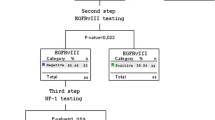Abstract
“Low-grade gliomas” (LGGs), classification of which is derived from histopathological observations, exhibit significant heterogeneity in clinical behavior. Recently, increasing attention has been paid to genomic analyses of these tumors, to aid in treatment and prognostic decision-making. We discuss herein the recent genomic analysis of gliomas from two major recent publications, and also the results of seminal LGG trials in the context of molecular and genomic stratification, with respect to both prognosis and response to therapy. We also analyze implications of these “molecular classifications”. We propose separating out the worst prognostic subsets, whose outcomes resemble those of glioblastoma patients. Lastly, a brief discussion is provided regarding translating this collective knowledge into the clinic and in treatment decisions; also addressed are some of the many questions that still need to be examined in light of these strong and emerging data.
Similar content being viewed by others
References
WHO Classification of Tumours of the Central Nervous System (2007) Louis DN, Ohgaki H, Wiestler OD, Cavenee WK (eds) IARC Press, Lyon
Eckel-Passow JE, Lachance DH, Molinaro AM et al (2015) Glioma groups based on 1p/19q, IDH, and TERT promoter mutations in tumors. N Engl J Med 372(26):2499–2508
The Cancer Genome Atlas Research Network (2015) Comprehensive, integrative genomic analysis of diffuse lower-grade gliomas. N Engl J Med 372(26):2481–2498
Shaw EG, Wang M, Coons SW et al (2012) Randomized trial of radiation therapy plus procarbazine, lomustine, and vincristine chemotherapy for supratentorial adult low-grade glioma: initial results of RTOG 9802. J Clin Oncol 30(25):3065–3070
Buckner JC, Shaw EG, Pugh SL et al (2016) Radiation plus procarbazine, CCNU, and vincristine in low-grade glioma. N Engl J Med 374(14):1344–1355
Buckner J, Shaw E, Pugh S et al (2015) IDH1 R132H mutations in NRG Oncology/RTOG 9802: phase III study of radiation therapy (RT) alone vs RT plus procarbazine, CCNU, and vincristine (PCV) in patients with low grade glioma. Presented at Society for Neuro-oncology 2015 annual meeting, San Antonio, Texas
Baumert BG, Hegi ME, Mason WP et al (2015) Radiotherapy in relation to temozolomide: subgroup analysis of molecular markers of the randomized phase III study by the EORTC/NCIC-CTG/TROG/MRC-CTU (EORTC 22033-26033) in patients with a high risk low-grade glioma. J Clin Oncol 33:S15
Cairncross JG, Wang M, Jenkins RB et al (2014) Benefit from procarbazine, lomustine, and vincristine in oligodendroglial tumors is associated with mutation of IDH. J Clin Oncol 32(8):783–790
Chang SM, Zhang P, Cairncross JG et al (2015) Results of NRG oncology/RTOG 9813: a phase III randomized study of radiation therapy (RT) and temozolomide (TMZ) versus RT and nitrosourea (NU) therapy for anaplastic astrocytoma (AA). J Clin Oncol 33 (suppl;abstr2002)
Yan H, Parsons DW, Jin G et al (2009) IDH1 and IDH2 mutations in gliomas. N Engl J Med 360(8):765–773
Chang S, Peixin Z, Cairncross GJ et al (2015) Results of NRG Oncology/RTOG 9813: a phase III randomized study of radiation therapy (RT) and temozolomide (TMZ) versus RT and nitrosourea (NU) therapy for anaplastic astrocytoma (AA). J Clin Oncol 2–15;15S:96s (abstract 2002)
Agnihotri S, Aldape KD, Zadeh G (2014) Isocitrate dehydrogenase status and molecular subclasses of glioma and glioblastoma. Neurosurg Focus 37:E13
Ceccarelli M, Barthel FP, Malta TM et al (2016) Molecular profiling reveals biologically discrete subsets and pathways of progression in diffuse glioma. Cell 164:550–563
Cahill DP, Sloan AE, Nahed BV et al (2015) The role of neuropathology in the management of patients with diffuse low grade glioma: a systematic review and evidence-based clinical practice guideline. J Neurooncol 125:531–549
Huse JT, Aldape KD (2013) The molecular landscape of diffuse glioma and prospects for biomarker development. Expert Opin Med Diagn 7:573–587
Huse JT, Wallace M, Aldape KD et al (2014) Where are we now? And where are we going? A report from the Accelerate Brain Cancer Cure (ABC2) low-grade glioma research workshop. Neuro Oncol 16:173–178
Vogelbaum MA, Hu C, Peereboom DM et al (2015) Phase II trial of pre-irradiation and concurrent temozolomide in patients with newly diagnosed anaplastic oligodendrogliomas and mixed anaplastic oligoastrocytomas: long term results of RTOG BR0131. J Neurooncol 124:413–420
Fisher BJ, Hu C, Macdonald DR et al (2015) Phase 2 study of temozolomide-based chemoradiation therapy for high-risk low-grade gliomas: preliminary results of Radiation Therapy Oncology Group 0424. Int J Radiat Oncol Biol Phys 91:497–504
Molenaar RJ, Botman D, Smits MA et al (2015) Radioprotection of IDH1-mutated cancer cells by the IDH1-mutant inhibitor AGI-5198. Cancer Res. doi:10.1158/0008-5472.CAN-14-3603
Beiko J, Suki D, Hess KR et al (2014) IDH1 mutant malignant astrocytomas are more amenable to surgical resection and have a survival benefit associated with maximal surgical resection. Neuro Oncol 16:81–91
Duffau HA (2013) New philosophy in surgery for diffuse low-grade glioma (DLGG): oncological and functional outcomes. Neurochirurgie 59:2–8
Duffau H (2016) Long-term outcomes after supratotal resection of diffuse low-grade gliomas: a consecutive series with 11-year follow-up. Acta Neurochir (Wien). doi:10.1007/s00701-015-2621-3
Dang L, White DW, Gross S et al (2009) Cancer-associated IDH1 mutations produce 2-hydroxyglutarate. Nature 462:739–744
de la Fuente MI, Young RJ, Rubel J et al (2016) Integration of 2-hydroxyglutarate-proton magnetic resonance spectroscopy into clinical practice for disease monitoring in isocitrate dehydrogenase-mutant glioma. Neuro Oncol 18:283–290
Clinical Trial NCT02465060. NCI-MATCH: Targeted Therapy Directed by Genetic Testing in Treating Patients With Advanced Refractory Solid Tumors or Lymphomas. https://clinicaltrials.gov/ct2/show/NCT02465060. Accessed November 11, 2015
Author information
Authors and Affiliations
Corresponding author
Ethics declarations
Conflict of interest
MPM has served as a consultant for Abbott, Bristol-Meyers-Squibb, Celldex, Cavion, Elekta, Novartis, Novocure, and Roche; has research funding from Novocure and Cellectar; has served in a leadership capacity on the Pharmacyclics BOD (with stock options); and serves on the Data Monitoring and Safety Board of Monteris.
Rights and permissions
About this article
Cite this article
Verma, V., Mehta, M.P. Clinical ramifications of “genomic staging” of low-grade gliomas. J Neurooncol 129, 195–199 (2016). https://doi.org/10.1007/s11060-016-2192-z
Received:
Accepted:
Published:
Issue Date:
DOI: https://doi.org/10.1007/s11060-016-2192-z




